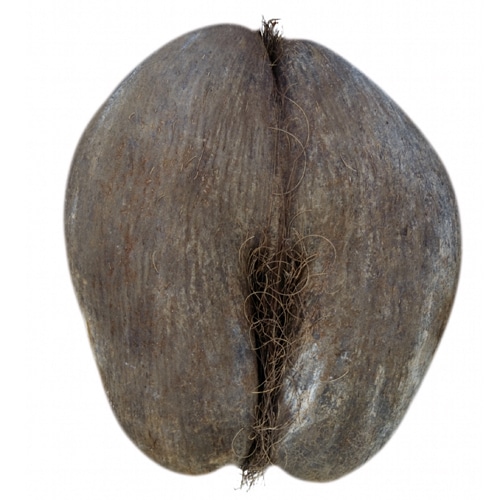Coco De Mer: The Love Nut
I'm concerned. What if the world's largest and most valuable nut, which can grow bigger than a beach ball and weigh in at more than 50 pounds, crashes down and conks me on the head? The Vallée de Mai Nature Reserve on Praslin has ranked near the top of my gotta-get-there destinations since I first read about it in ISLANDS in the 1980s. But now, as I move along the winding clay path that leads beneath its mysterious and most notable inhabitants (the gargantuan nuts), I walk scared.
"Not to worry," says Terry Morel, a guide with the tour operator Seven Degrees South. He can tell what I'm thinking from the way I look up at the coco de mer palms that soar overhead. "The nuts only fall at night."
I might believe him, but the coco de mer is a magnet for myth and outright malarkey. Ancient sailors, who found huge coco de mer nuts floating in the Indian Ocean, thought they came from some mystical underwater island. Sailors being sailors, desirous and delirious from long months at sea, they applied numerous nicknames to the coco de mer, including the "love nut," thanks to its rather startling resemblance to a female derriere. The 19th-century discovery that the coco de mer, a "forbidden fruit" if ever there was one, grows only in Seychelles, led to speculation that these islands were home to the biblical Garden of Eden.
A visit to the Vallée de Mai Nature Reserve could turn the most hardened skeptics of the Eden theory into at least semi-believers. While pocket-size at just 48 acres, making it one of the smallest preserves on the list of UNESCO World Heritage Sites, Vallée de Mai has scarcely changed from primeval times. As I follow Terry through the preserve, a brief storm erupts and a sharp rat-a-tat-tat resounds from above as rain pounds down. I expect to get drenched, but not a drop reaches us beneath the cathedral-like canopy. Terry pats the trunk of a nearby coco de mer.
"Makes quite a fine umbrella, don't you think?"
It is an honor to be in the mere presence of these nuts. The coco de mer is a serious cash crop in the Seychelles, and the nuts have become the de facto national symbol. My passport, stamped at the airport, now bears its winsome image, and I've seen countless gewgaw replicas in every island gift shop. That's as close as many visitors come to the real thing. ∏o control a black market in the nuts and put the squeeze on poaching, the government claims ownership of all 11,414 coco de mer trees known to exist in the country, even if they grow on private property. Anyone found illegally harvesting a nut is subject to a fine of about $5,000 and five years in prison. Terry tells me the story of a tourist from China who tried to smuggle a nut out of the preserve in his backpack but was caught by one of the many security guards.
"He didn't have to go to prison," says Terry, "but it created something of an international incident. Our nation is very tiny, and this preserve is its heart and soul."
As we approach the oldest coco de mer in the forest, a noble 85-footer thought to be more than 300 years old, Terry holds up a hand for me to stop.
"Listen," he whispers. "Do you hear it?"
I tune in to the soft chorus that surrounds us — the scrape of branch against branch, the whisper of broad fronds, the groan and sway of ancient trunks, the moan of time.
"The trees have voices," Terry says.
Locked in the wonder of this moment, I cannot possibly speak, let alone argue.
